England
1872-1960
The Football Association (FA) was formed on 26 October 1862 by representatives of ten English clubs who sought to create a unified set of rules and a framework for future competition. Unlike every other national association, the FA does not include the name of its host country in its title.
References:
England Football Online - a freelance source for information on the history of the English national side. Not easy to navigate but well worth the effort, especially for the detailed history of England's playing kit. Unless otherwise stated, graphics and commentary come from this source.
True Colours 2 (John Devlin 2006 ISBN 13 9780713679281) - John's definitive work is a reliable and detailed source additionally used for graphics 1980-2008 unless otherwise stated.
First choice and change kits are labelled in Bold Text while variants are labelled in Italics.
 1872-1900
1872-1900
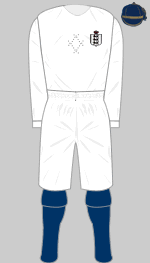
1872-1880
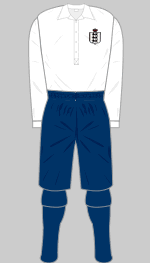
1882-1900
Designer:
On 30 November 1872 at the ground of the West of Scotland Cricket Club in Glasgow, the first ever international association football match took place between England and Scotland. A representative match between English and Scottish players had been organised on 5 March 1870 but as both teams were chosen by the English FA committee, this is not considered to be a true international match.
England wore white jerseys emblazoned with the three lions crest of the Football Association, white knickers, navy hose and caps. The original jerseys had a diamond design woven into the fabric in the centre of the chest.
England and Scotland continued to meet each March and England played in all-white at least until 1880 when records lapse. In March 1882 England wore navy blue knickers for the first time. In 1883-84 the Home International tournament was established.
 1900-1914
1900-1914
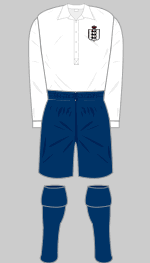
1900-1914
Designer:
As the popularity of association football spread beyond the United Kingdom so did the need for an overall governing body. The four Home Associations rejected the idea and it was left to the Football Associations of Belgium, France, Denmark, the Netherlands, Spain, Sweden and Switzerland to form the Fédération Internationales des Football Associations (FIFA).
England joined FIFA in April 1905 and played their first games against European opposition on a tour in June 1908, when they contested three matches against Austria, Hungary and Bohemia (all part of the Austro-Hungarian Empire). These were the only teams from outside the British Isles that England played prior to the outbreak of the First World War.
Although the FA provided the flannel shirts, players were expected to provide their own navy blue knickers and club stockings.
 1920-1939
1920-1939
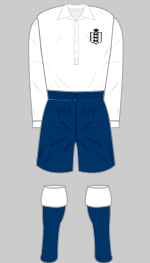
1920-1934
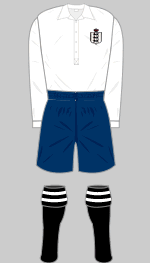
1934
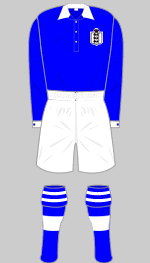
1930s change
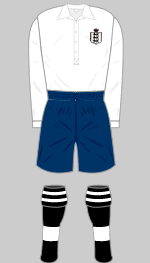
1938
Designer:
The Home International competition resumed in April 1920 when the UK associations effectively boycotted FIFA. As a result of this short-sighted policy, England did not take part in the inaugural World Cup in 1930 nor the 1934 competition, held in Italy. They did, however, play several international matches against European teams and for the first time a change strip was needed (for games with Austria and Germany which were played for the first time in May 1930). Players continued to wear their club stockings until 1934 when the FA finally issued standard sets.
Numbers were worn on the back of players' shirts for the first time at Hampden Park on 17 April 1937.
 1946-1949
1946-1949
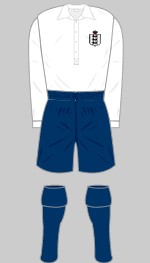
1946 1949
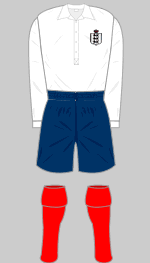
1946-1949 Alternate
Designer: St. Blair
When England resumed international football in 1946, the team wore plain navy stockings but against opponents wearing blue, navy or black socks, players wore red instead. This was such a frequent occurrence that almost half of their games between 1946 and 1952 were played in red stockings.
 1949-1954
1949-1954
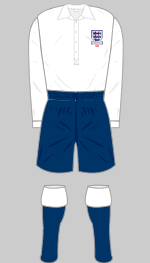
1949-Oct 1953
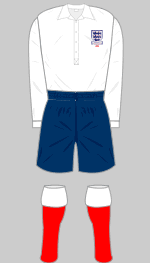
1949-Oct 1953 Alternate
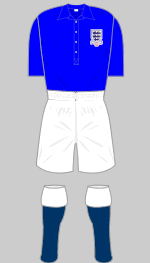
29 June 1950 v USA World Cup Finals
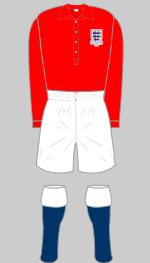
9 May 1951 v Argentina
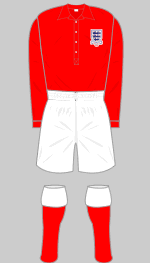
1952-1953 Change
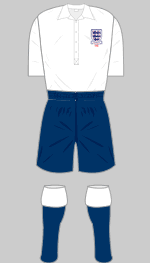
May 1953 South American Tour

Oct 1953-Apr 1954

Oct 1953-Apr 1954 Alternate

May 1954
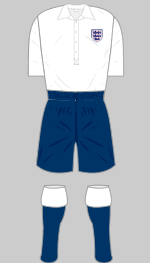
20 June 1954 v Switzerland

26 June 1954 v Uruguay
Designer: St Blair (1949-1952) Umbro (1952-1954)
In 1949 a new crest, designed by the College of Arms was introduced: the traditional three lions were redesigned and ten tudor roses added, one for each of the FA regions and the badge was enhanced by a crescent shaped scroll with the name of England's opponent and the year.
England had rejoined FIFA in 1946 and in 1950, they entered the World Cup for the first time. After a famous defeat at the hands of the United States, England failed to progress beyond the first round. The blue change shirts worn for the occasion were immediately dropped and the next time colours clashed, the team wore red instead (with orange numbers no less).
In 1953 England were beaten at home 3-6 by Hungary, the first time a team from outside the British Isles had won at Wembley. This was followed by a 1-7 thrashing in the return game but the FA establishment was slow to absorb the lessons and the team continued to be picked by committee. The team then went on tour to Argentina, Chile and Uruguay wearing short sleeved shirts, the FA being apparently unaware that May is the onset of Autumn in these countries. Short sleeves were reinstated for the summer internationals in May 1954.
 1954-1960
1954-1960
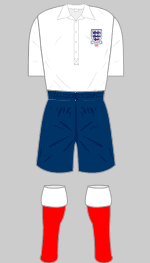
2 Oct 1954 v N Ireland
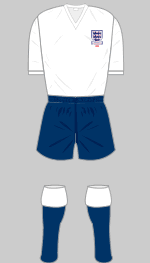
10 Nov 1954-1957
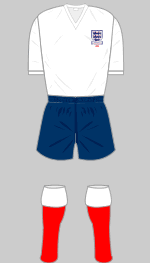
1954-1957 Alternate
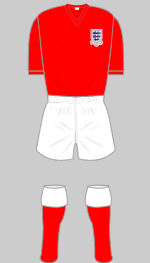
1954-1957 Change
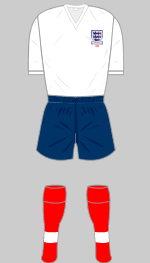
1957-1960
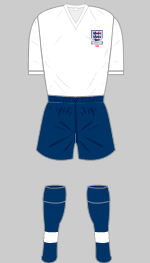
1957-1960 v Wales
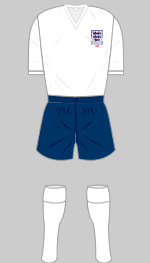
27 Nov 1957 v France
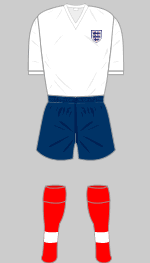
1958 World Cup Finals

13 May 1959 v Brazil
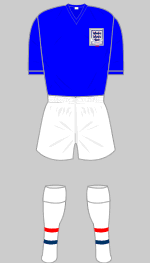
17 May 1959 v Peru
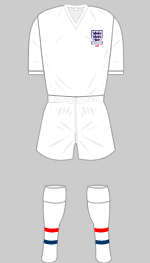
24 May 1959 v Mexico

15 May 1960 v Spain
Designer: Umbro
The FA international committee may not have concluded that they needed to change their approach to picking and coaching the team but they did introduce a new streamlined playing kit (popularly known as "Continental"), worn for the first time on November 10 1954 against Wales. The colour of England's stockings varied between red and navy (navy with white turnovers were the official first choice until 1957) as before and the numbers on players' shirts were coordinated to match them. The red change kit was used only twice, in games against West Germany.
In 1957 the old bulky woollen stockings were replaced with modern lightweight versions in all-red with a white hoop at the calf. Navy sets were used for games against Wales, France, the USSR and other teams who wore red stockings. For the 1958 World Cup the scroll underneath the crest was dispensed with due to the difficulty of producing these should England progress beyond the group stage.
Three variants appeared on the South American tour of 1959 including a revival of the blue shirt last seen when England lost against the United States. A 1-4 thrashing at the hands of Peru has ensured that England have never worn blue shirts since. The new white stockings with red and blue bands introduced for the game against Mexico were also used against Yugoslavia in May 1960.
Navy stockings with a white calf band were worn against Wales between 1957 and 1960 and also against the USSR on 22 October 1958.
England 1960-1983 >





























